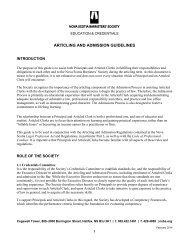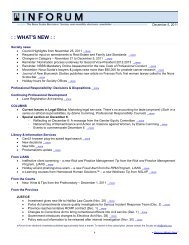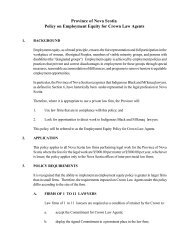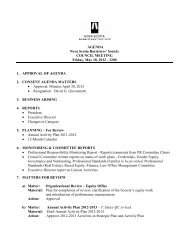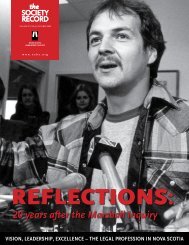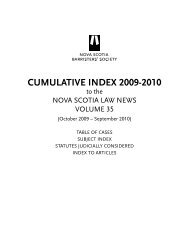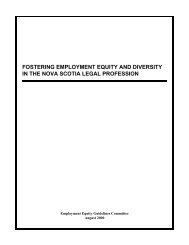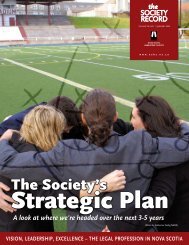SR Vol 25 No 1, January 2007 - Nova Scotia Barristers' Society
SR Vol 25 No 1, January 2007 - Nova Scotia Barristers' Society
SR Vol 25 No 1, January 2007 - Nova Scotia Barristers' Society
You also want an ePaper? Increase the reach of your titles
YUMPU automatically turns print PDFs into web optimized ePapers that Google loves.
thepresident’sviewrecently had occasion to speak at an All Courts Conference inI Halifax – sponsored by the National Judicial Institute – on theissue of courthouse security. Various other stakeholders werealso present in order to give their perspective on this issue– currently high on the radar screen of judges, lawyers, government,and the public in general. I’d like to share a brief summaryof my thoughts, as conveyed at that conference.Before making any hard and fast decisions on this issue, Ibelieve it’s important to first identify and outline the variousissues and concepts which need to be addressed. I see thoseissues as follows:1) Conducting a proper risk assessment – Before jumpinginto this quagmire feet first, the appropriate authorities mustdetermine where and how tax dollars are best spent. We needonly look at the goings on in a courtroom, on any given day,to see that emotions often run high (which we’ve all witnessedat one time or another), and often come on both quickly andunpredictably. It is important, through further investigation,to develop a mechanism whereby certain types of cases orcourtrooms are identified as being more likely to experience anincident than others, while always recognizing the possibilityfor an incident to occur in any legal forum. Suffice it to saythat a risk assessment is crucial to identifying the best use oflimited tax dollars.2) Costs – This leads me into the second important issue –costs. Obviously, as with any other situation, the governmentwill not have unlimited resources or monies at its disposal.When attempting to effect appropriate changes, it must bedetermined whether new money will be expended in this area,and if so, to what extent. Equally important is whether taxdollars are going to be diverted from other important issues,or to the potential detriment of other programs or groups ofpeople. Obviously, not everybody is going to be satisfied withthe end results of any assessment.3) Proportionality – The present line of thinking wouldseem to indicate that the types of programs that may beimplemented in one area will not necessarily be consistentthroughout the Province. In making decisions as to where andhow to enact new procedures, the system needs to be able toprovide adequate responses as to why substantial changes arebeing made in some courts, while little or no change is madein others. While nobody is suggesting that certain courts orjudges are more important than others, the authorities shouldnonetheless be prepared (and have appropriate responsesin place) to answer those who may question the need formechanisms in place in some areas and not others.These issues have been the subject of considerable discussionamong the Judiciary, the Department of Justice, the <strong>No</strong>va <strong>Scotia</strong>Barristers’ <strong>Society</strong>, as well as other stakeholders. In attemptingto craft a solution, we must not lose sight of public perceptionwith respect to access to justice and the openness of the justicesystem. It is important that we not create a regime whichappears to offer a measure of privilege to judges, lawyers, orother participants in the system. We must also be careful not tocreate a system which makes us look (to the public and others)as if we are using a sledgehammer to kill a flea. It’s a finebalance to strike.We must take both a principled and yet practical approachand strive to implement measured appropriate responses andsafeguards to potential acts of violence in our courtrooms. <strong>January</strong> <strong>2007</strong>



